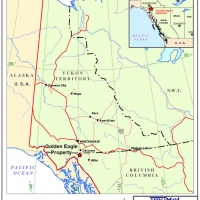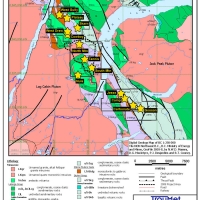Golden Eagle
| Target: | Intrusion related bulk-tonnage gold, vein-hosted high-grade gold-silver and volcanogenic massive sulphide (VMS) deposits |
| Location: | 90 km south of Whitehorse, Yukon Territory |
| Property: | 26 contiguous mineral claims totalling 8,178 ha |
| Ownership: | 100% |
Highlights
Golden Eagle is situated at the southern end of the Tintina Gold Belt, a 2,000 km long arc-shaped metallogenic belt that stretches across Alaska and Yukon and into northern British Columbia. The belt hosts many intrusion-related gold deposits such as Pogo (Alaska), Fort Knox (Alaska) and Dublin Gulch (Yukon). Over 50 million ounces of lode gold resources have been defined within the belt in the last 20 years. In addition to gold, the belt is also host to copper, lead, zinc, silver and tungsten deposits.
The style and areal extent of mineralization at Golden Eagle strongly suggest the presence of a reduced intrusion-related gold system (RIRGS). These systems are characterized by widespread arrays of sheeted auriferous quartz veins, forming bulk-tonnage, low-grade gold deposits at the top of small plutons. Well known examples include the Fort Knox and Dublin Gulch deposits of the Tintina Gold Belt. RIRGS also include a wide range of intrusion-related mineral deposit styles including skarns, replacements and distal veins that form within the region of hydrothermal influence surrounding the causative pluton. All of these characteristics are well represented over the 25 km span of the Golden Eagle property, where 13 separate mineralized zones have been identified to date.
Current Status
Troymet has identified a highly prospective area with high discovery potential over a 2.5 km distance between the Skarn and Catfish mineralized zones; drill-ready targets have been delineated.
Previous Work
Troymet’s early exploration on the property focused on the Middle Ridge/Tannis area, where high-grade gold-silver mineralization is hosted in pyrite and arsenopyrite bearing quartz veins/structures within rhyolitic intrusive, granitic intrusive and to a lesser extent in flanking metavolcanics. Troymet tested the Tannis zone from 2005-2008 with 16 core holes over a 250 m strike length. The drilling returned a number of high-grade gold and silver intercepts; however, grade and continuity of the quartz-sulphide veins were found to be highly variable along strike and at depth (Table 1). A geologic mapping and prospecting program undertaken in 2008 further defined the quartz-sulphide vein system at Tannis along a northwest trend nearly 5 km in length ( February 24, 2009 news release). To date, only a limited portion of the Tannis zone has been drill tested as an intrusive-hosted gold target, with drilling largely confined to the younger rhyolitic intrusive. The possible roots of the vein system in the larger underlying granitic phase have not been targeted and deeper drilling in this area is required.
Troymet’s exploration from 2009 onward has focused on a 5 x 5 km area at the northern tip of the property known as the North Prospect, where multiple zones of gold-silver-arsenic-antimony mineralization (e.g. Plateau, Skarn, Cowboy, West Gully and West Draw zones) and gold-in-soil anomalies occur. The mineralization and the anomalies on the North prospect are related to two major structures, the Ben Fault and the Paddy Fault, and to an underlying granite-related gold system. Both faults both are possible splays of the Llewellyn fault zone, a regionally significant structure that cuts through the project area and has a strong correlation with the majority of mineral occurrences in the region.
Troymet drilled 5 widely spaced core holes in 2009 on the West Gully, West Draw and LQ zones ( February 17, 2010 news release). Follow-up drilling was conducted in 2011, with 5 holes at West Draw and 1 hole on the Skarn zone ( February 16, 2012 news release). Results from the two drilling campaigns are presented in Table 2.
Hole N11-06 was drilled on the Skarn zone to test an area of historic drilling from which no drill core exists. The hole intersected 36.45 m grading 1.27 g/t gold in altered felsic volcanics, identifying a new bulk tonnage gold target that is open at depth and southwards along the Paddy Fault towards the Catfish zone ( October 20, 2014 news release). A reconnaissance prospecting program conducted in 2014 on the southern extension of the Skarn zone identified elevated to anomalous gold, silver, arsenic, bismuth, copper, mercury, antimony and tellurium values within an area of approximately 1,300 m x 900 m along the Paddy Fault system (view maps). Mineralized samples collected along the trend exhibit similar alteration and quartz-ankerite veining to that at the Skarn zone. The fault system, which controls the Skarn zone mineralization, is a major structural feature up to 500 m wide that has been traced over a 17 km strike length.
Results of 2014 prospecting program indicate that the Skarn zone mineralization extends a significant distance towards the Catfish zone, 2.5 km south, where gold-silver bearing veins occur in the head waters of creeks carrying anomalous gold-in-silt values. Troymet considers this a highly prospective area with high discovery potential.
Geology
The Golden Eagle property lies along the eastern margin of the Late Cretaceous-Tertiary intrusives of the Coast Belt within arc volcanic and arc-derived sedimentary rocks of the Intermontane Belt. The regionally significant, northwest-trending Llewellyn fault zone cuts through the eastern side of property and has a strong correlation with the majority of BC Minfile occurrences in the region.
Mineralization styles on the property vary. The northern block (North Prospect) contains fault hosted gold-silver skarn mineralization in volcanics and disseminated gold mineralization in intrusive rocks. The central block (North Mountain, Middle Ridge/Tannis and South Mountain) contains gold-silver bearing quartz veins hosted in intrusive and volcanic rocks. The southern block includes an area of quartz-carbonate stockwork veining in mafic volcanics that is variably mineralized with gold, copper and zinc.
Technical Reports
![]() NI 43-101 Technical Report on the Golden Eagle Property – May 30, 2012 (23.7 Mb)
NI 43-101 Technical Report on the Golden Eagle Property – May 30, 2012 (23.7 Mb)

 Property Location Map
Property Location Map  Geology & Target Zones
Geology & Target Zones 